Networking Technologies Worksheet - University Networking Technologies
VerifiedAdded on 2023/01/13
|7
|974
|32
Homework Assignment
AI Summary
This document presents a detailed solution to a Networking Technologies worksheet, addressing key concepts in computer networking. The solution begins by explaining the purpose of Automatic Private IP Addressing (APIPA) and its role in network configuration. It then delves into IP addressing and subnetting, providing a practical example of subnetting a Class B network (172.16.100.0/22) to accommodate various network sizes, including 32, 64, 128, and 256 IP addresses. Furthermore, the solution explains how switches use MAC addresses to forward packets and why they do not share switching table information like routers. It also clarifies the role of routers in facilitating communication between different VLANs. The document includes a reflection exercise summarizing the learning outcomes and challenges faced during the module, along with a list of relevant references.
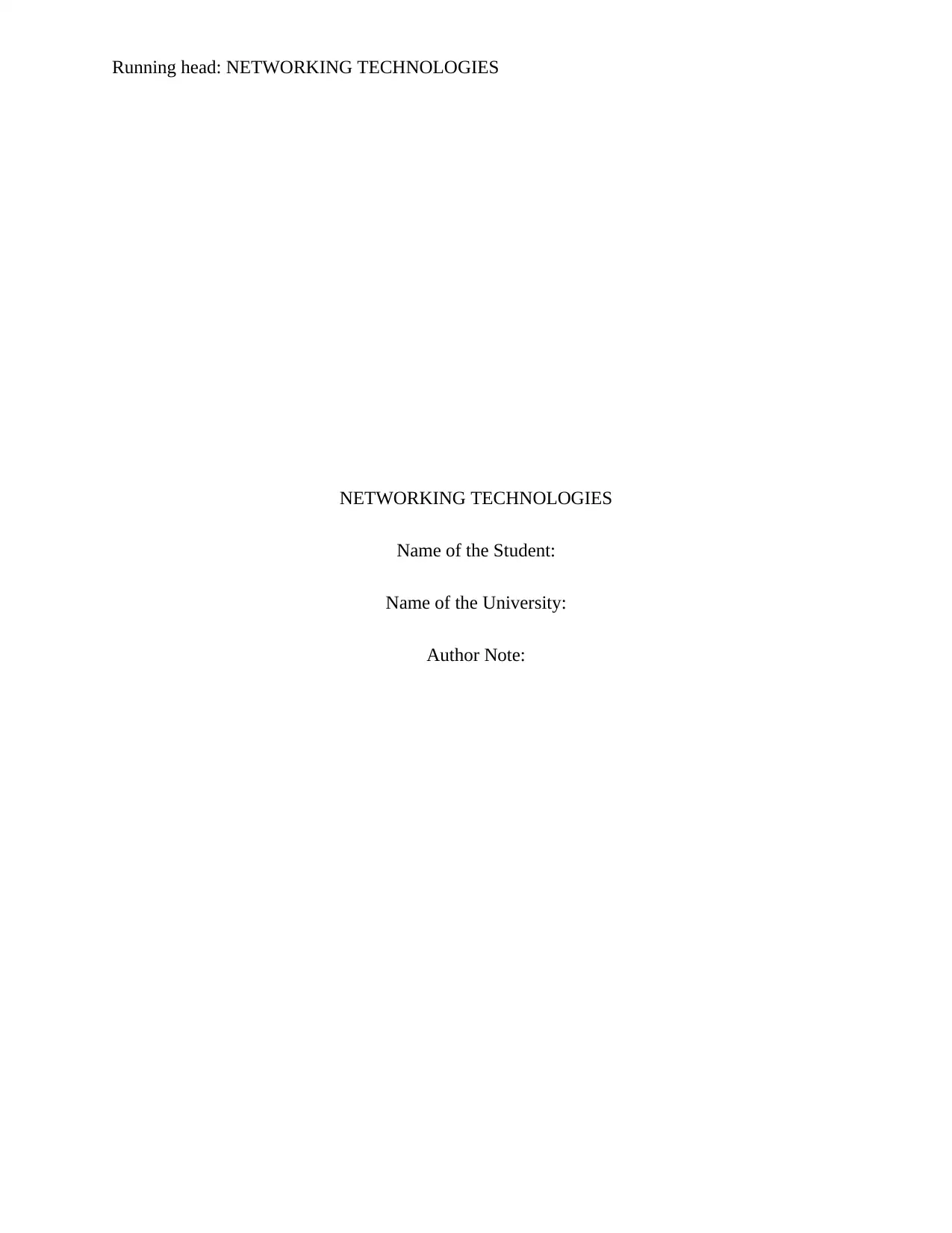
Running head: NETWORKING TECHNOLOGIES
NETWORKING TECHNOLOGIES
Name of the Student:
Name of the University:
Author Note:
NETWORKING TECHNOLOGIES
Name of the Student:
Name of the University:
Author Note:
Paraphrase This Document
Need a fresh take? Get an instant paraphrase of this document with our AI Paraphraser
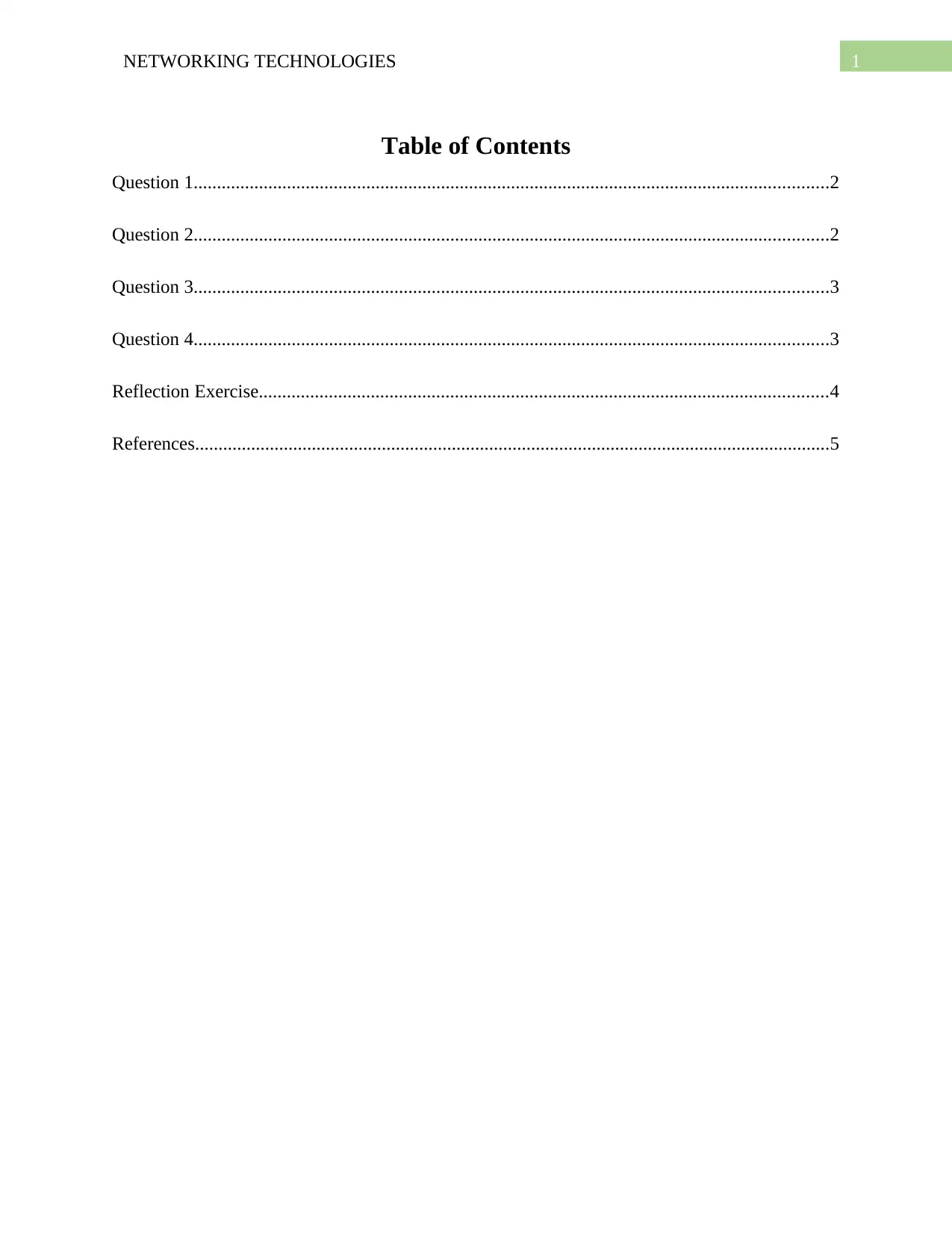
1NETWORKING TECHNOLOGIES
Table of Contents
Question 1........................................................................................................................................2
Question 2........................................................................................................................................2
Question 3........................................................................................................................................3
Question 4........................................................................................................................................3
Reflection Exercise..........................................................................................................................4
References........................................................................................................................................5
Table of Contents
Question 1........................................................................................................................................2
Question 2........................................................................................................................................2
Question 3........................................................................................................................................3
Question 4........................................................................................................................................3
Reflection Exercise..........................................................................................................................4
References........................................................................................................................................5
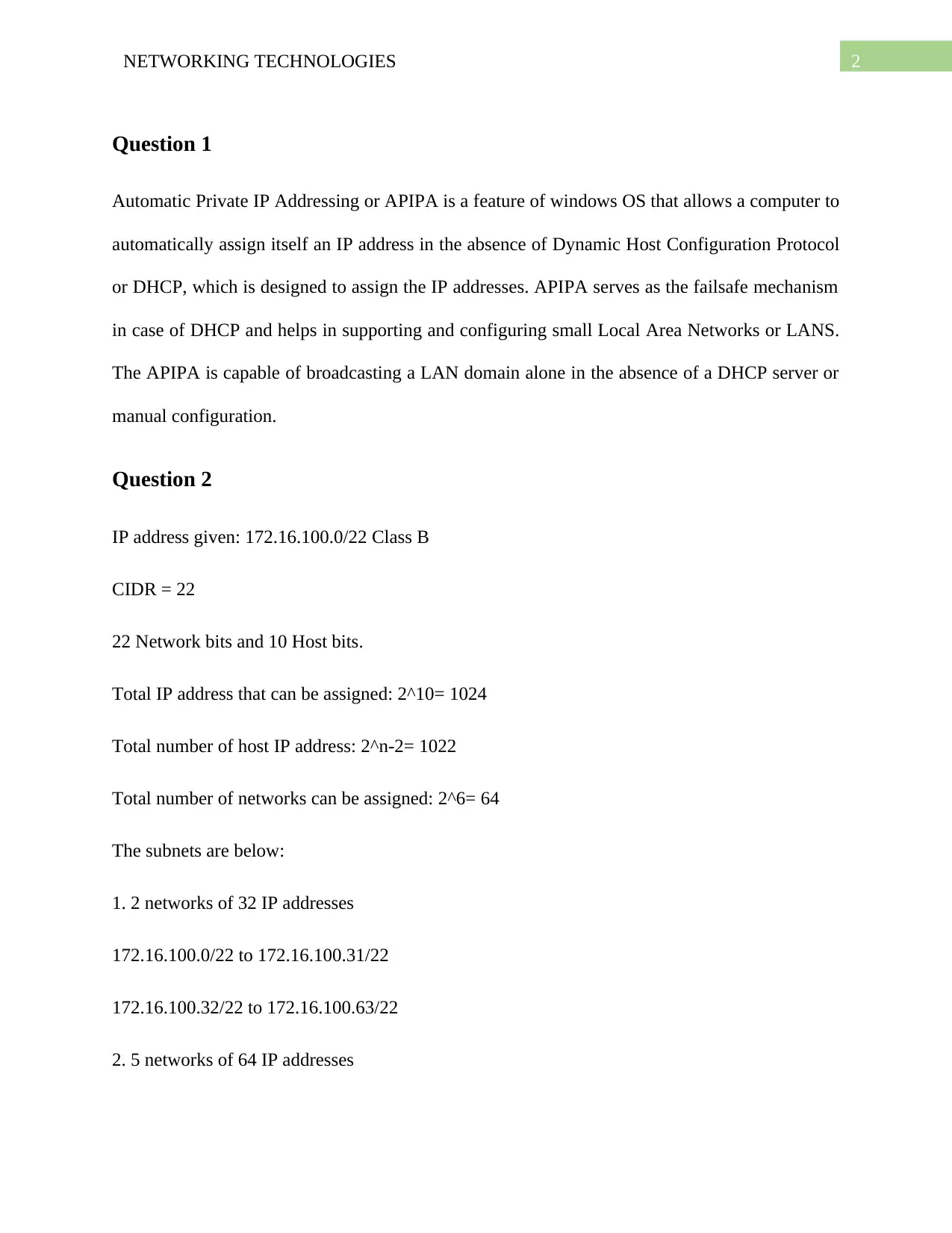
2NETWORKING TECHNOLOGIES
Question 1
Automatic Private IP Addressing or APIPA is a feature of windows OS that allows a computer to
automatically assign itself an IP address in the absence of Dynamic Host Configuration Protocol
or DHCP, which is designed to assign the IP addresses. APIPA serves as the failsafe mechanism
in case of DHCP and helps in supporting and configuring small Local Area Networks or LANS.
The APIPA is capable of broadcasting a LAN domain alone in the absence of a DHCP server or
manual configuration.
Question 2
IP address given: 172.16.100.0/22 Class B
CIDR = 22
22 Network bits and 10 Host bits.
Total IP address that can be assigned: 2^10= 1024
Total number of host IP address: 2^n-2= 1022
Total number of networks can be assigned: 2^6= 64
The subnets are below:
1. 2 networks of 32 IP addresses
172.16.100.0/22 to 172.16.100.31/22
172.16.100.32/22 to 172.16.100.63/22
2. 5 networks of 64 IP addresses
Question 1
Automatic Private IP Addressing or APIPA is a feature of windows OS that allows a computer to
automatically assign itself an IP address in the absence of Dynamic Host Configuration Protocol
or DHCP, which is designed to assign the IP addresses. APIPA serves as the failsafe mechanism
in case of DHCP and helps in supporting and configuring small Local Area Networks or LANS.
The APIPA is capable of broadcasting a LAN domain alone in the absence of a DHCP server or
manual configuration.
Question 2
IP address given: 172.16.100.0/22 Class B
CIDR = 22
22 Network bits and 10 Host bits.
Total IP address that can be assigned: 2^10= 1024
Total number of host IP address: 2^n-2= 1022
Total number of networks can be assigned: 2^6= 64
The subnets are below:
1. 2 networks of 32 IP addresses
172.16.100.0/22 to 172.16.100.31/22
172.16.100.32/22 to 172.16.100.63/22
2. 5 networks of 64 IP addresses
⊘ This is a preview!⊘
Do you want full access?
Subscribe today to unlock all pages.

Trusted by 1+ million students worldwide

3NETWORKING TECHNOLOGIES
172.16.100.64/22 to 172.16.100.127/22
172.16.100.129/22 to 172.16.100.191/22
172.16.100.193/22 to 172.16.100.255/22
172.16.101.0/23 to 172.16.101.63/23
172.16.101.64/23 to 172.16.101.127/23
3. 3 networks of 128 IP addresses
172.16.101.128/23 to 172.16.101.255/23
172.16.102.0/24 to 172.16.102.127/24
172.16.102.128/24 to 172.16.102.255/24
4. 1 network of 256 IP addresses
172.16.103.0/25 to 172.16.103.255/25
Question 3
Switches use Media Access Control or MAC addresses to determine their receiver of the packet.
Whenever an unknown device sends a packet to the switch, the switch keeps a note of the
address of the unknown device and adds it to the information table. Therefore, whenever it
receives a destination MAC address, it first checks it with its address book and if the address is
found, it sends the packet or it floods all the devices connected to the switch. This mechanism
enables the switch to send the information to the exact correct device and improves the security
of the network.
172.16.100.64/22 to 172.16.100.127/22
172.16.100.129/22 to 172.16.100.191/22
172.16.100.193/22 to 172.16.100.255/22
172.16.101.0/23 to 172.16.101.63/23
172.16.101.64/23 to 172.16.101.127/23
3. 3 networks of 128 IP addresses
172.16.101.128/23 to 172.16.101.255/23
172.16.102.0/24 to 172.16.102.127/24
172.16.102.128/24 to 172.16.102.255/24
4. 1 network of 256 IP addresses
172.16.103.0/25 to 172.16.103.255/25
Question 3
Switches use Media Access Control or MAC addresses to determine their receiver of the packet.
Whenever an unknown device sends a packet to the switch, the switch keeps a note of the
address of the unknown device and adds it to the information table. Therefore, whenever it
receives a destination MAC address, it first checks it with its address book and if the address is
found, it sends the packet or it floods all the devices connected to the switch. This mechanism
enables the switch to send the information to the exact correct device and improves the security
of the network.
Paraphrase This Document
Need a fresh take? Get an instant paraphrase of this document with our AI Paraphraser
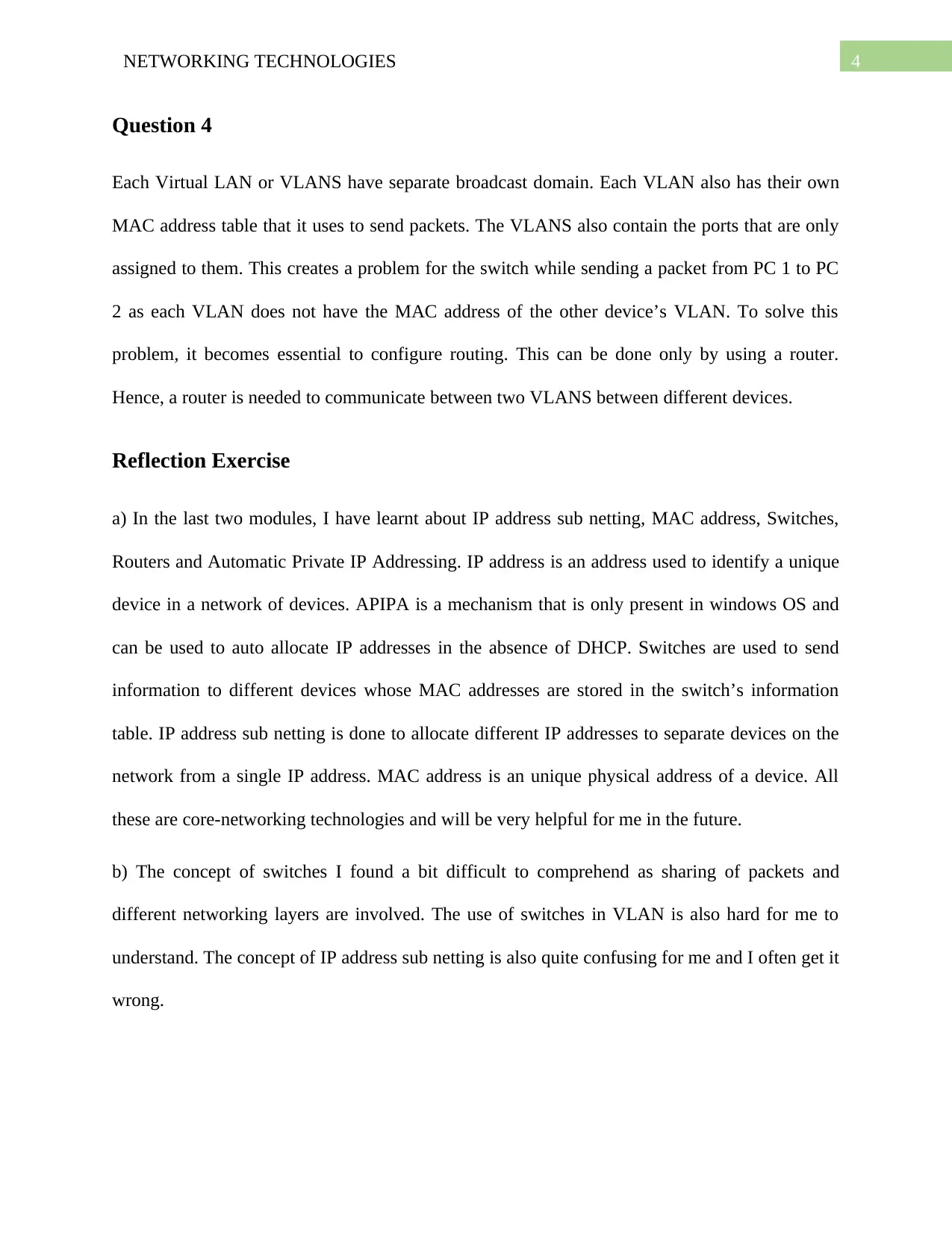
4NETWORKING TECHNOLOGIES
Question 4
Each Virtual LAN or VLANS have separate broadcast domain. Each VLAN also has their own
MAC address table that it uses to send packets. The VLANS also contain the ports that are only
assigned to them. This creates a problem for the switch while sending a packet from PC 1 to PC
2 as each VLAN does not have the MAC address of the other device’s VLAN. To solve this
problem, it becomes essential to configure routing. This can be done only by using a router.
Hence, a router is needed to communicate between two VLANS between different devices.
Reflection Exercise
a) In the last two modules, I have learnt about IP address sub netting, MAC address, Switches,
Routers and Automatic Private IP Addressing. IP address is an address used to identify a unique
device in a network of devices. APIPA is a mechanism that is only present in windows OS and
can be used to auto allocate IP addresses in the absence of DHCP. Switches are used to send
information to different devices whose MAC addresses are stored in the switch’s information
table. IP address sub netting is done to allocate different IP addresses to separate devices on the
network from a single IP address. MAC address is an unique physical address of a device. All
these are core-networking technologies and will be very helpful for me in the future.
b) The concept of switches I found a bit difficult to comprehend as sharing of packets and
different networking layers are involved. The use of switches in VLAN is also hard for me to
understand. The concept of IP address sub netting is also quite confusing for me and I often get it
wrong.
Question 4
Each Virtual LAN or VLANS have separate broadcast domain. Each VLAN also has their own
MAC address table that it uses to send packets. The VLANS also contain the ports that are only
assigned to them. This creates a problem for the switch while sending a packet from PC 1 to PC
2 as each VLAN does not have the MAC address of the other device’s VLAN. To solve this
problem, it becomes essential to configure routing. This can be done only by using a router.
Hence, a router is needed to communicate between two VLANS between different devices.
Reflection Exercise
a) In the last two modules, I have learnt about IP address sub netting, MAC address, Switches,
Routers and Automatic Private IP Addressing. IP address is an address used to identify a unique
device in a network of devices. APIPA is a mechanism that is only present in windows OS and
can be used to auto allocate IP addresses in the absence of DHCP. Switches are used to send
information to different devices whose MAC addresses are stored in the switch’s information
table. IP address sub netting is done to allocate different IP addresses to separate devices on the
network from a single IP address. MAC address is an unique physical address of a device. All
these are core-networking technologies and will be very helpful for me in the future.
b) The concept of switches I found a bit difficult to comprehend as sharing of packets and
different networking layers are involved. The use of switches in VLAN is also hard for me to
understand. The concept of IP address sub netting is also quite confusing for me and I often get it
wrong.
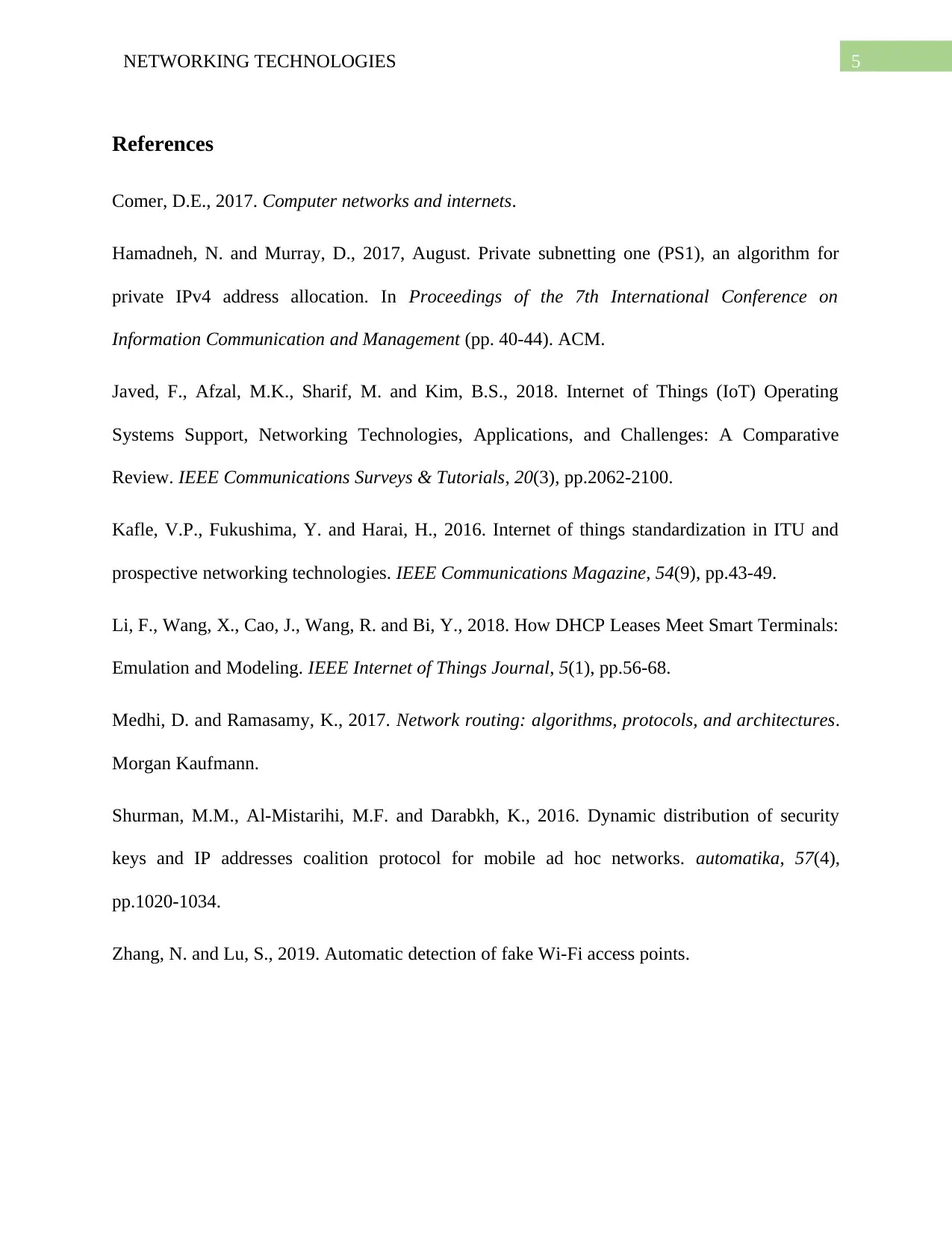
5NETWORKING TECHNOLOGIES
References
Comer, D.E., 2017. Computer networks and internets.
Hamadneh, N. and Murray, D., 2017, August. Private subnetting one (PS1), an algorithm for
private IPv4 address allocation. In Proceedings of the 7th International Conference on
Information Communication and Management (pp. 40-44). ACM.
Javed, F., Afzal, M.K., Sharif, M. and Kim, B.S., 2018. Internet of Things (IoT) Operating
Systems Support, Networking Technologies, Applications, and Challenges: A Comparative
Review. IEEE Communications Surveys & Tutorials, 20(3), pp.2062-2100.
Kafle, V.P., Fukushima, Y. and Harai, H., 2016. Internet of things standardization in ITU and
prospective networking technologies. IEEE Communications Magazine, 54(9), pp.43-49.
Li, F., Wang, X., Cao, J., Wang, R. and Bi, Y., 2018. How DHCP Leases Meet Smart Terminals:
Emulation and Modeling. IEEE Internet of Things Journal, 5(1), pp.56-68.
Medhi, D. and Ramasamy, K., 2017. Network routing: algorithms, protocols, and architectures.
Morgan Kaufmann.
Shurman, M.M., Al-Mistarihi, M.F. and Darabkh, K., 2016. Dynamic distribution of security
keys and IP addresses coalition protocol for mobile ad hoc networks. automatika, 57(4),
pp.1020-1034.
Zhang, N. and Lu, S., 2019. Automatic detection of fake Wi-Fi access points.
References
Comer, D.E., 2017. Computer networks and internets.
Hamadneh, N. and Murray, D., 2017, August. Private subnetting one (PS1), an algorithm for
private IPv4 address allocation. In Proceedings of the 7th International Conference on
Information Communication and Management (pp. 40-44). ACM.
Javed, F., Afzal, M.K., Sharif, M. and Kim, B.S., 2018. Internet of Things (IoT) Operating
Systems Support, Networking Technologies, Applications, and Challenges: A Comparative
Review. IEEE Communications Surveys & Tutorials, 20(3), pp.2062-2100.
Kafle, V.P., Fukushima, Y. and Harai, H., 2016. Internet of things standardization in ITU and
prospective networking technologies. IEEE Communications Magazine, 54(9), pp.43-49.
Li, F., Wang, X., Cao, J., Wang, R. and Bi, Y., 2018. How DHCP Leases Meet Smart Terminals:
Emulation and Modeling. IEEE Internet of Things Journal, 5(1), pp.56-68.
Medhi, D. and Ramasamy, K., 2017. Network routing: algorithms, protocols, and architectures.
Morgan Kaufmann.
Shurman, M.M., Al-Mistarihi, M.F. and Darabkh, K., 2016. Dynamic distribution of security
keys and IP addresses coalition protocol for mobile ad hoc networks. automatika, 57(4),
pp.1020-1034.
Zhang, N. and Lu, S., 2019. Automatic detection of fake Wi-Fi access points.
⊘ This is a preview!⊘
Do you want full access?
Subscribe today to unlock all pages.

Trusted by 1+ million students worldwide

6NETWORKING TECHNOLOGIES
1 out of 7
Related Documents
Your All-in-One AI-Powered Toolkit for Academic Success.
+13062052269
info@desklib.com
Available 24*7 on WhatsApp / Email
![[object Object]](/_next/static/media/star-bottom.7253800d.svg)
Unlock your academic potential
Copyright © 2020–2025 A2Z Services. All Rights Reserved. Developed and managed by ZUCOL.



